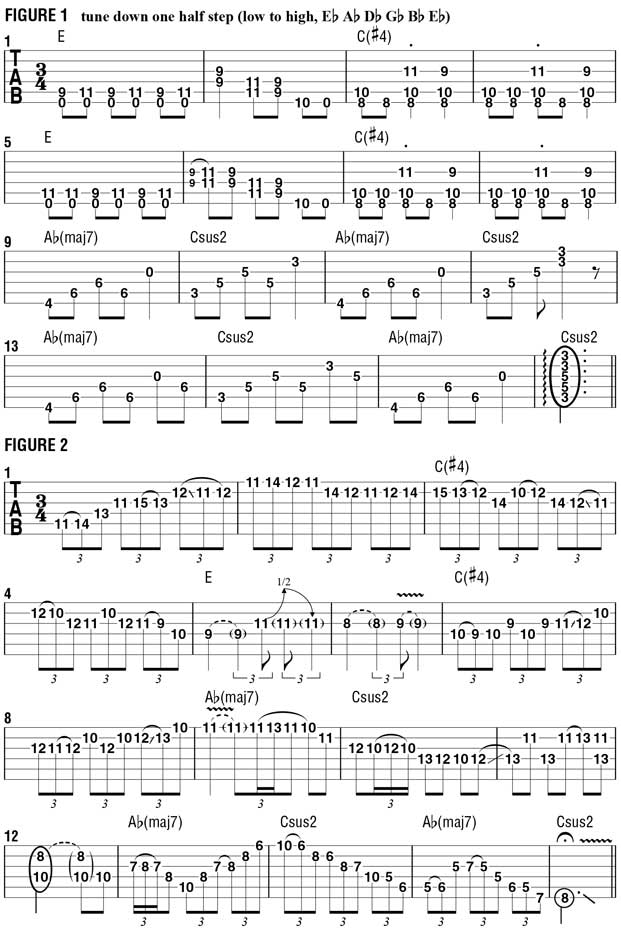Odd Couplings: More Approaches to Soloing in Odd Meters
There’s something very cool about a sudden shift in the music that throws the listener for a moment, followed by a return to the groove.
Last month, I talked about the concept of incorporating odd and shifting meters, or time signatures, in the music of Revocation.
To my ears, there’s something very cool about a sudden shift in the music that throws the listener for a moment, followed by a return to the groove. This approach also encourages different interpretations of where the downbeat, or “one,” really is. In truth, many of the multi-meter phrases I write could be analyzed and counted in a variety of ways.
A great example of this musical approach in action is the song “Profanum Vulgus” from the new Revocation album, Great Is Our Sin.
This month, I’d like to present the rhythm part and solo from another new song, “Crumbling Imperium.”
“Crumbling Imperium” is played in 3/4 time and shifts back and forth between different tonal centers. FIGURE 1 illustrates the rhythm part played behind the solo: in bars 1–8, I repeatedly alternate between two bars of E major and two bars of C major, referencing E major via dyads (two-note chords) and incorporating the open low E string as a pedal tone, and spicing up C major with the inclusion of the s4 (or #11), F#, which creates a C Lydian sound (C D E F# G A B).
In bars 9–16, a nod toward C minor becomes the focal point, with the use of Ab(maj7) and Csus2; Abmaj7 is a chord that “lives” within the key of C minor, and, likewise, Cm falls within the key of Ab major. I arpeggiate both the Ab(maj7) and Csus2 chords, picking each note individually and in succession while letting them ring, using a picking pattern of down-down-down-down-up-down.
FIGURE 2 illustrates the solo, and I begin with an arpeggiation of G#m7 (G# B D# F#), which is superimposed over the E major chord. I also include A# as a passing tone, again creating a Lydian sound, in this case, E Lydian (E F# G# A# B C# D#). Bar 3 features a chordal shift to C(#4), so I initiate that shift with a move of a half-step, from C# to D, and then descend through the C Lydian mode, ultimately landing on a B note in bar 5, which brings me back to the E Lydian sound. Bars 7 and 8 offer a return to C Lydian, and once again I use a half-step shift, from D to Eb, to move to the Ab (maj7) chord in bar 9.
In bars 11 and 12, I use hybrid picking (pick-and-fingers technique) to sound the series of fifths fretted on the D and B strings. For the final solo phase, in bars 13–16, I stick with C natural minor (C D Eb F G Ab Bb), but offer a subtle reference to C harmonic minor (C D Eb F G Ab B) by playing a B note right before the final C.

Get The Pick Newsletter
All the latest guitar news, interviews, lessons, reviews, deals and more, direct to your inbox!
“There are so many sounds to be discovered when you get away from using a pick”: Jared James Nichols shows you how to add “snap, crackle and pop” to your playing with banjo rolls and string snaps
Don't let chord inversions bamboozle you. It's simply the case of shuffling the notes around







![Joe Bonamassa [left] wears a deep blue suit and polka-dotted shirt and plays his green refin Strat; the late Irish blues legend Rory Gallagher [right] screams and inflicts some punishment on his heavily worn number one Stratocaster.](https://cdn.mos.cms.futurecdn.net/cw28h7UBcTVfTLs7p7eiLe.jpg)


